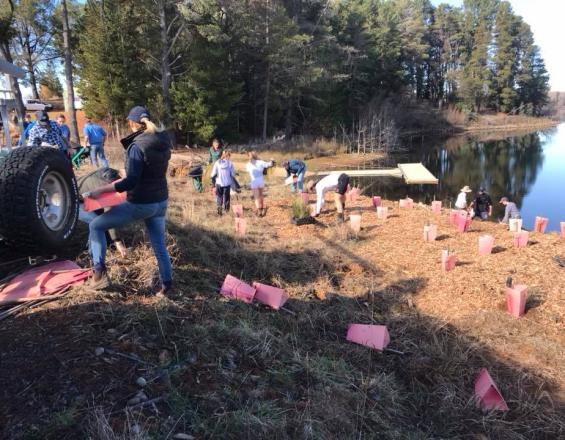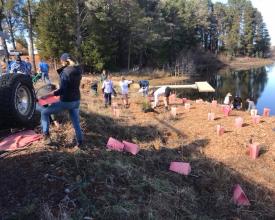
Remeros y restauración en Spring Creek, Nueva Gales del Sur

El programa de remo de la escuela Wolaroi de Kinross puso en marcha un proyecto para restaurar las tierras degradadas que rodean el embalse de Spring Creek. El embalse, propiedad de la ciudad y al que acuden a practicar los remeros de la escuela, está separado de las tierras agrícolas sólo por una pequeña franja de vegetación compuesta en su mayor parte por plantas alóctonas e invasoras. Estas plantas consumen más agua que las especies autóctonas, lo que agrava aún más los efectos de las actuales condiciones de sequía, que han reducido el embalse al 30% de su capacidad. La escorrentía de los cultivos cercanos compromete la calidad del agua, lo que supone un problema para los remeros locales, así como para dos especies de patos en peligro de extinción que se observan en el embalse. Con el fin de crear una zona hermosa y saludable para el deporte y un hábitat de alta calidad para las aves, los remeros presentaron un plan de restauración al ayuntamiento para obtener su apoyo. Siguiendo las orientaciones de un consultor medioambiental y con financiación municipal, el equipo organizó jornadas de trabajo comunitario para eliminar las especies invasoras de una parte de la orilla y plantar plantas autóctonas.
Impactos
La eliminación de los sedientos árboles no autóctonos ha reducido la demanda del embalse, sometido a estrés por sequía, dejando más agua para la biodiversidad y las actividades de remo. Las zonas fluviales urbanas suelen estar degradadas, y los esfuerzos de mejora como los realizados en Spring Creek pueden tener importantes repercusiones en la biodiversidad local. Para incentivar futuros esfuerzos de sostenibilidad y conservación por parte de la comunidad de remo, la Federación Mundial de Remo (FISA) reconoce contribuciones excepcionales como el proyecto de Spring Creek con el Premio Mundial a la Sostenibilidad del Remo. La FISA proporciona a los remeros directrices para hacer hincapié en los impactos positivos sobre la biodiversidad en la planificación de eventos y sedes a través de sus objetivos de sostenibilidad. De este modo, la federación deportiva, el equipo deportivo local y la ciudad anfitriona pueden trabajar juntos para apoyar resultados positivos en materia de biodiversidad. El proyecto consiguió movilizar a la comunidad local para llevar a cabo una labor vital de restauración ecológica. Los planes futuros incluyen vincular la labor de restauración con los planes de estudio escolares y seguir ampliando la zona de hábitats de alta calidad alrededor del embalse.



